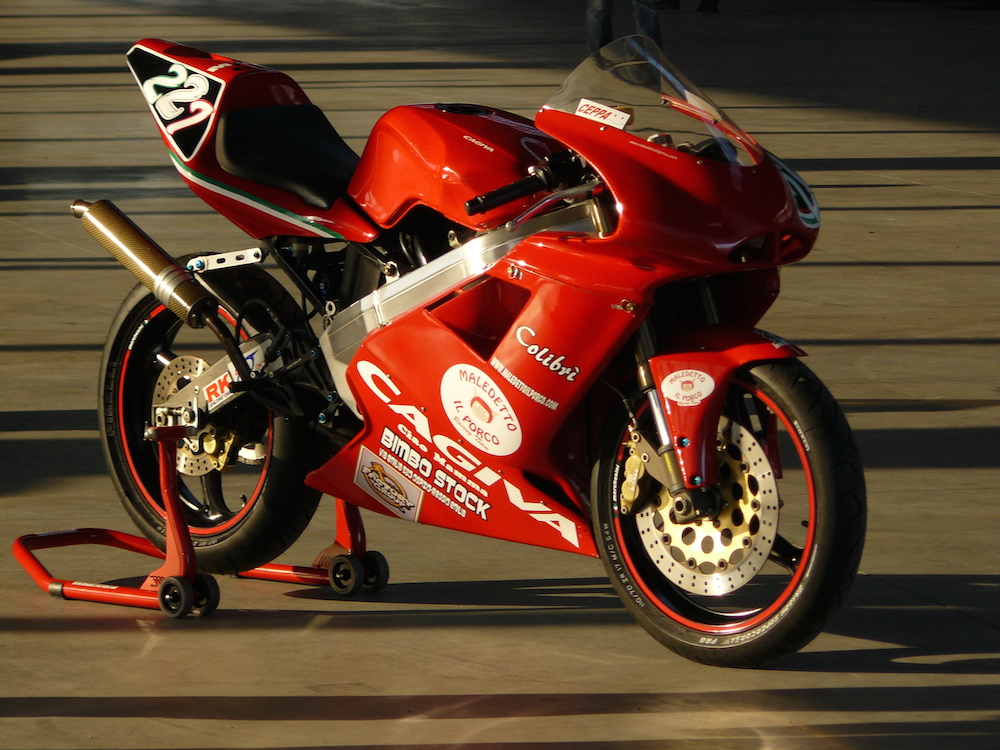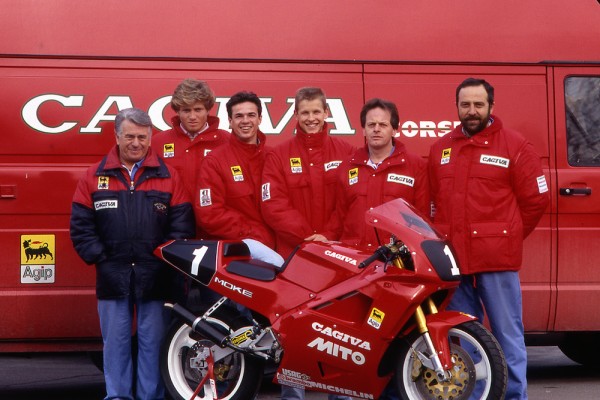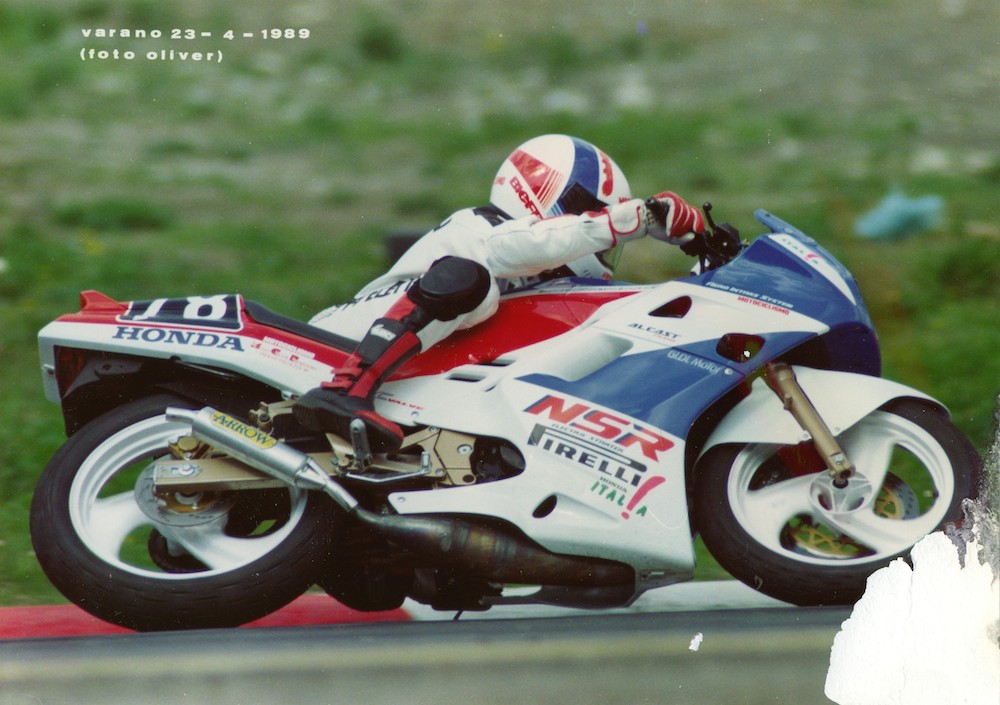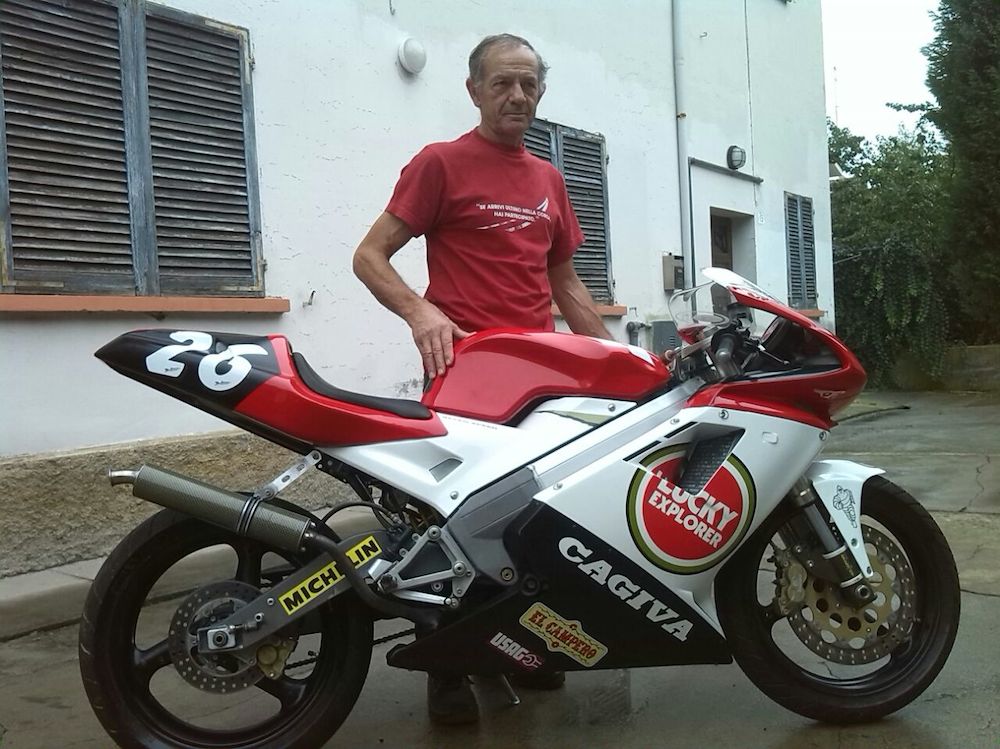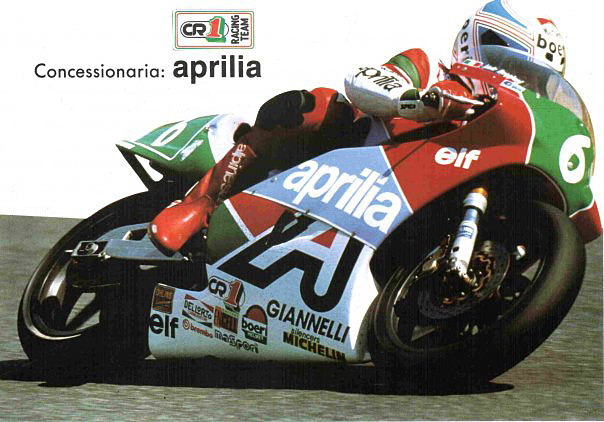125stradali ringrazia Michele Prontelli, meglio conosciuto nel web come “Ceppa”, autore dell’interessantissimo articolo che vi presentiamo in anteprima mondiale sulla Cagiva Mito in versione Sport Production.
125stradali ringrazia anche il gruppo MV Agusta e Cagiva per aver dato la loro approvazione alla pubblicazione dell’articolo che segue.
125 Sport Production, un nome che rievoca griglie piene (addirittura, selettive A –B – C…), giovani talenti e moto speciali; questo era il Campionato Italiano 125 Sport Production. I reparti marketing delle varie case impegnate nella 125 SP (Aprilia, Cagiva, Honda, Gilera e Yamaha) puntavano molto sul risalto mediatico di tale competizione, seguendo la strada del “vinci la domenica, vendi il lunedì”. Per non parlare dei Reparti Corse o Esperienze delle varie aziende le quali sfornavano kit che trasformavano la 125 con la quale un sedicenne andava tranquillamente a scuola al mattino, in un missile terra-aria.
In questo spaccato parleremo dell’evoluzione della Cagiva Mito nelle competizioni Sport Production, partendo dalla primissima versione, la Mito 125 SP “Mini Moke”.
– Cagiva Mito Sport Production “Mini Moke” 1991
La prima Mito allestita in versione Sport Production è datata 1991 e vede la luce in quel di Monza per un test speciale con tanto di piloti ufficiali quali Davide Bulega (125 over), Franco Latini (collaudatore) e con la guest star (per motivi promozionali) Eddie Lawson con tanto di tuta completa con logo “Mito” in bella vista. L’obiettivo è chiaro fin da subito e la gestazione all’interno del Reparto Corse Cagiva la dice lunga; la vittoria della 125 Sport Production 1991 è alla portata della casa Varesina.
La moto, in vendita a 7 milioni e 600 mila lire può essere acquistata regolarmente da tutti i piloti che intendono partecipare al Campionato Sport Production e viene fornita direttamente dalla casa in configurazione da regolamento 1991, ma dato che si tratta di un progetto ex novo, lo sviluppo del mezzo viene esclusivamente affidato a Davide Bulega e al suo team ufficiale in quanto la realizzazione e la produzione di un kit SP da fornire ai clienti è ancora in fase embrionale. La prima serie si riconosce per la scritta Mini Moke su codone.
Una volta alzato il telo coprimoto, le linee della Mito in questa versione “SP” rendono onore alla matita di Tamburini e la somiglianza di tale 125 con la C590 di Randy Mamola è molto più che una semplice affermazione. La stampa viviseziona subito la moto durante la presentazione a Monza e subito, rispetto al modello di serie, si notano diversi particolari degni di una moto da gran premio e nel particolare, l’ammortizzatore di sterzo laterale regolabile con attacco al telaio.
Il regolamento è piuttosto restrittivo: viene mantenuto il carburatore da 28 mm di serie e, rispetto al modello stradale, cambiano solamente i tubi dei freni, ora in teflon con maglia di acciaio e la trasmissione, adesso passo 415 con corone in ergal Cagiva CHT. Come pneumatici sono confermati gli ottimi Michelin Radial nelle misure di 100/80 all’anteriore e 150/60 al posteriore. La carenatura completa in vetroresina con plexiglass a “doppia bombatura” e copri sellino posteriore realizzato ad hoc per l’occasione, così come il supporto anteriore del cupolino leggermante differentemente dalla controparte stradale per consentire ai piloti una migliore visibilità nella posizione “in carena”.
Le sospensioni vedono all’anteriore la splendida forcella Marzocchi a steli tradizionali migliorata nell’idraulica e l’adozione al posteriore di un inedito ammortizzatore G.C.B. (Gazzaniga, Ceriani e Bianchi) pluriregolabile con serbatoio esterno. Le pedane arretrate sono montate su splendidi supporti in alluminio per migliorare e modificare la posizione in sella del pilota (20 mm alzate, 50 mm arretrate rispetto alle standard).
Per quanto riguarda il propulsore i tecnici Cagiva (ovviamente) non si sono sbilanciati molto; la moto è equipaggiata con un cilindro serie 6 SP (marchiati 66433 e 66650) e relativa espansione realizzata sempre dal Reparto Corse Cagiva con silenziatore in alluminio (carbonio non ancora ammesso dal regolamento), pistone originale (sempre secondo la fiche) e testa opportunatamente modificata, così come il pacco lamellare. L’avviamento e’ elettrico , secondo quanto dettato dal restrittivo regolamento Sport Production 1991.
La foto che vedete sotto, su gentile concessione Cagiva, ritrae un ibrido. Si tratta infatti di una prima serie “Mini Moke” 1991, ma dotata già di alcuni componenti della versione 1992, come si nota chiaramente dalle forcelle con steli rovesciati.
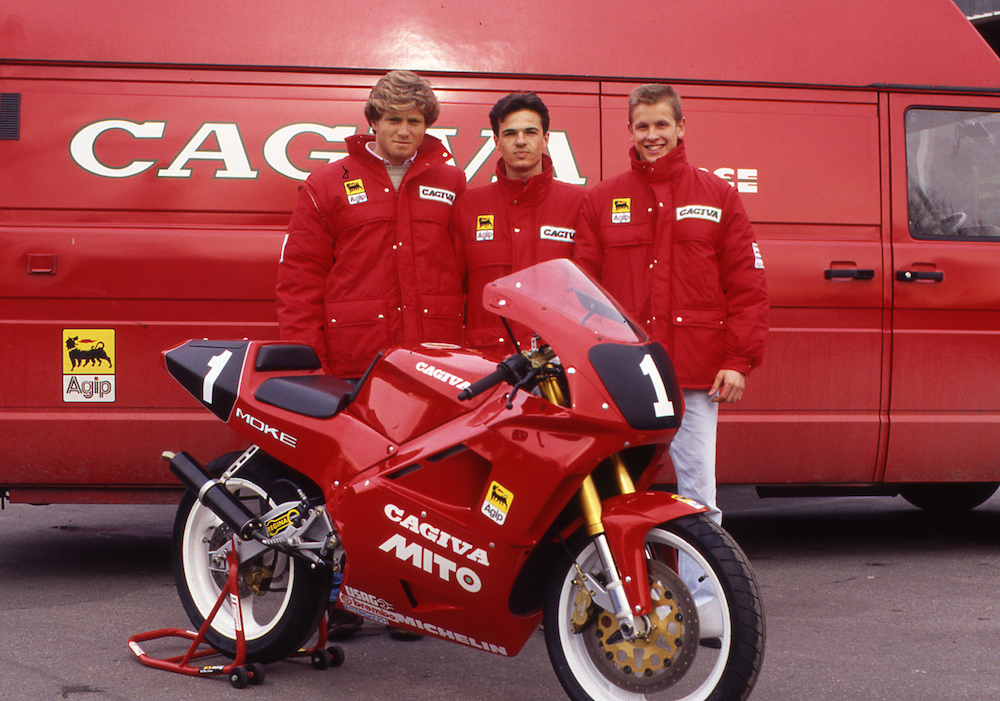
– Cagiva Mito Sport Production 1992
Lo sviluppo effettuato nel corso del 1991 ha portato i suoi frutti in quel di Varese. La Mito realizzata per la stagione 1992 mantiene le stesse caratteristiche peculiari che hanno permesso a Bulega di vincere tutte le gare delle selettive; ma (complici anche le modifiche regolamentari) adotta diversi upgrade.
La prima evidente novità è l’adozione della forcella “upside down” con foderi color oro realizzata dalla Marzocchi (differente anche il parafango anteriore) sempre con steli da 40 mm ed escursione di 120 mm, ma a “doppia molla” e riconoscibile per i due fori di apertura vicino la brugola per accedere alle mezzelune di fissaggio.
La seconda peculiarità della moto è data dall’adozione di pregiatissimi cerchi prodotti dalla Marchesini (confermate le Michelin TX), realizzati esclusivamente per l’ottavo di litro Varesina, aventi il logo dell’elefantino della Cagiva e la “M” di Marchesini all’interno delle razze; il cerchio anteriore adotta un disco Brembo flottante da 320 mm.
La termica viene aggiornata e la moto viene fornita con un cilindro serie 7 SP (marchiati 72625 e 72626), con pistone a due segmenti e relativa testa. L’avviamento e’ elettrico ed utilizza lo stesso sistema della moto di serie.
Per festeggiare il titolo italiano di Bellei, Cagiva rilascia a listino la Cagiva Mito 2 avente tabelle porta numero nere (come da regolamento SP) e adesivi degli sponsor tecnici; livrea che lascia letteralmente senza fiato.Le 125 stradali di Varese vengono acquistate da molti team e piloti, grazie a quanto ottenuto nella stagione precedente, che evolvono il proprio mezzo secondo quanto sviluppato dal Reparto Corse Cagiva (diversi team acquistano la moto in configurazione SP, Zerbo e Rovelli corrono con una moto Kit gestita da un team esterno; pratica che negli anni successivi sarà ripresa più volte da altre squadre). Il team Lusuardi di Modena gestirà le Mito ufficiali, con pilota Roberto Bellei (affiancato da Salvatori e Rabitti) il quale, a fine stagione, porterà il tricolore in casa Cagiva. Dopo solo due stagioni la Cagiva Mito riesce a vincere il titolo del Campionato Italiano 125 Sport Production. L’obiettivo iniziale è stato ottenuto; le basi per un futuro radioso nelle competizioni sono già fissate. A Bulega e alla Mito spetta anche un record, tutt’ora imbattuto, ottenuto durante la 200 miglia di Monza del 1992; in questa occasione (con regolamento differente da quello più restrittivo della Sport Production) la Mito del pilota emiliano superò i 204 km7h… un vero record per una 125! (le accensioni Ducati Energia a rotore interno saranno sviluppate e testate nel corso di queste manifestazioni).
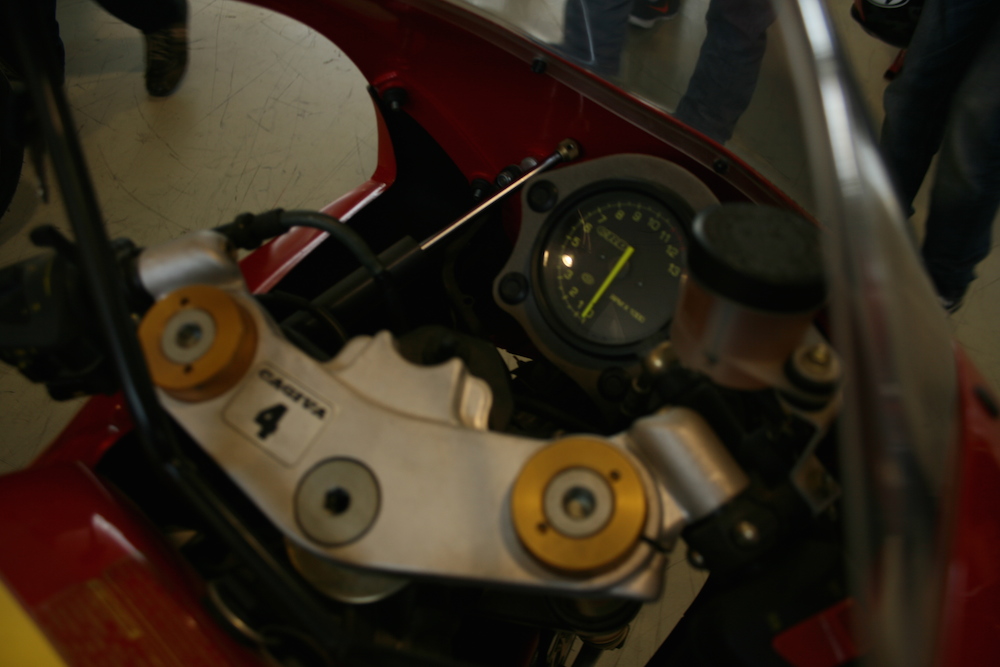
– Cagiva Mito Sport Production 1993 Lucky Explorer
Per la stagione 1993, Gilberto Milani e il suo staff hanno evoluto ulteriormente il concetto di “trasformazione” da moto Mito 125 stradale a Mito 125 SP. Il regolamento è essenzialmente il medesimo della scorsa edizione, salvo alcuni dettagli tecnici (limite rapporto di compressione e utilizzo pistone monosegmento per esempio) e di accensioni.
Rispetto alla passata stagione, lo sponsor Lucky Explorer si fa ben notare sulle carene delle Mito ufficiali, donando un look molto racing, accentuato dalla splendida tabella porta numero frontale. Rispetto alla versione precedente le forcelle Marzocchi upside down presentano i tappi ad esagono sui foderi, mentre l’ammortizzatore posteriore è il medesimo utilizzato negli anni precedenti. Il canale dei cerchi Marchesini per le moto ufficiali e’ di 3,50 al posteriore e 2,75 anteriore, in questa unità e’ stato anche eliminato il blocchetto di avviamento con un tasto “on – off” su semimanubrio destro, così come il pregevole tappo del serbatoio originale, ora sostituito con uno piu’ leggero a sgancio rapido.
Molte sono le novità apportate, partendo da quanto ottenuto nello sviluppo della stagione 1992. La parte elettronica vede ora installata un’accensione Ducati Energia a rotore interno la quale obbliga all’utilizzo di un differente disegno del perno dell’albero motore sinistro. Dotata di speciale centralina con anticipo regolabile (sono prodotte diverse centraline con differenti curve di anticipo) in luogo della Kokusan che equipaggia le Mito stradali (più pesante rispetto al rotore interno, l’avviamento rimane comunque elettrico come da regolamento), inoltre si adotta una frizione a denti dritti in luogo di quella elicoidali utilizzata fino alla passata stagione (così come sul motore di serie) oltre che a delle molle più resistenti.
L’impianto di scarico è in continua evoluzione e viene realizzato in base ai vari circuiti/esigenze di erogazione dei piloti Vittoriano Guareschi , Max Blaso e Bussei. Oltre al team interno Cagiva, vi sono molti altre squadre che hanno deciso di acquistare le Mito SP ,fra i quali piloti spiccano i nomi di Max Temporali e anche un timido Valentino Rossi.
Rispetto alla passata stagione, adesso il regolamento permette l’adozione di un pistone monosegmento più leggero e con relativa testa completamente lavorata per aumentare il volume della camera di combustione (codice 200I), utile per raggiungere il rapporto di compressione di 13,5:1. Addirittura viene alleggerito anche lo spinotto del pistone, il quale mantiene la misura di 16 mm ma è più corto di 2 mm rispetto a quello della versione 1992; oltre ad avere il foro biconico per eliminare il materiale non utile. I cilindri hanno codice 73037 (evoluzione di quello adottato sulla moto stradale), 72666 e 75666 destinati a piloti privati e ufficiali. Nell’ultimo step evolutivo di queste termiche si testavano particolari che verranno poi ripresi nei futuri Kit SP della casa Varesina.
Dal 1993 fino al 2001 compreso , il kit Sport Production e relativi componenti e’ regolarmente in vendita presso i concessionari o rivenditori autorizzati Cagiva; in soli 3 anni di sviluppo l’azienda è ora in grado di produrre e vendere articoli destinati ad uso agonistico sviluppati direttamente dal Reparto Corse interno. La lista è sempre in continuo aggiornamento: si spazia dai cilindri, alle accensioni con le diverse centraline e mappature, per passare poi ai cerchi Marchesini, espansioni e molto altro ancora.
Il 1993 e’ un anno molto importante per la Mito; il nuovo modello e’ nella fase finale di test e, per il 1994 (anno in cui e’ fissato il debutto della Cagiva Mito EV) la Mito EV SP ha l’obiettivo di ottenere, al debutto assoluto, la vittoria dell’italiano SP. Infatti,a conferma di cio’, durante il termine della stagione 1993 Cagiva comincio’ a sviluppare termiche differenti, con scarico quadro e pistone Mahle poi riprese direttamente nei test invernali del 1994 con la Mito EV.
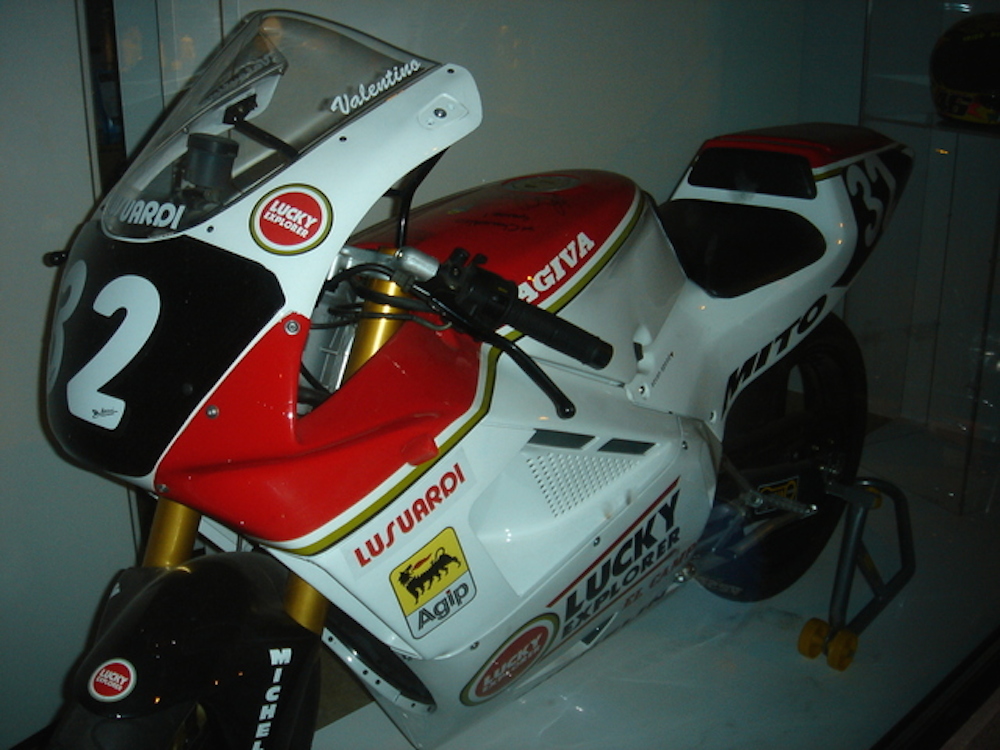
– Cagiva Mito EV Sport Production 1994 “Lucky Explorer”
Per la stagione 1994 la Cagiva schiera la nuovissima Mito EV, realizzata in quel del Centro Ricerche Cagiva dalla matita e l’estro di Massimo Tamburini e della sua equipe. Durante la presentazione stampa viene anche comunicato il kit SP per la stagione 1994; letteralmente “plug and play” composto da cilindro serie 8, testa 200M, pistone Mahle, espansione e silenziatore (quest’ultimo in kevlar , medesimo della moto di serie), corone – pignoni e trasmissione passo 415, nottolini per cavalletto posteriore, cavalletto alzamoto posteriore, accensione a rotore interno Ducati Energia e relativa centralina, scatola del filtro appositamente studiata dai tecnici Cagiva , disco flottante Brembo da 320mm, mono Ceriani ampiamento testato nel corso degli anni, arretratori pedane e cerchi Marchesini. Altrimenti, al prezzo di 8 milioni e 940 mila lire è disponibile la moto completa in livrea “Lucky Explorer” SP, con il sopra citato Kit già installato.
Per il 1994 sono molti i piloti gestiti da team esterni che acquistano la Mito EV ufficiale, si spazia da Valentino Rossi (team Luasuardi), a Dellino, per passare (categoria over) a Franco Battaini, Ruozi , Pagliarini e molti altri ancora. La moto è l’esatta evoluzione di quanto visto fino ad ora con la Mito 2; cambia il serbatoio (meno capiente ma più ergonomico per la posizione di guida del pilota), tutte le carenature realizzate direttamente in CRC sfruttando il know how ottenuto durante le competizioni GP, così come i telaietti anteriore e posteriore, con una differenza altezza da terra della sella. Il KIT SP essenzialmente resta il medesimo dell’edizione precedente; le uniche differenze sono nelle forcelle doppia molla, le quali adottano i foderi in color argento (l’interno non varia), mentre il cerchio posteriore Marchesini diventa a canale di 4,00. Sul finire della stagione verranno testati cilindri serie 8 (codice 81782) i quali prevedono una boccola di scarico apposita (scarico quadro), differente testa (200L) e differente espansione, oltre ad un pistone apposito.
Fra le altre modifiche adottate durante il corso dell’anno, vennero realizzati diversi componenti utili per alleggerire ulteriormente la moto (fino al peso limite consentito) quali il telaietto posteriore in alluminio, il supporto per la pinza posteriore lavorato a macchina, gli attacchi per le molle dell’espansione e anche un kit di accensione per la moto a “Kick starter”, in sostituzione del classico avviamento elettrico (concesso dal regolamento).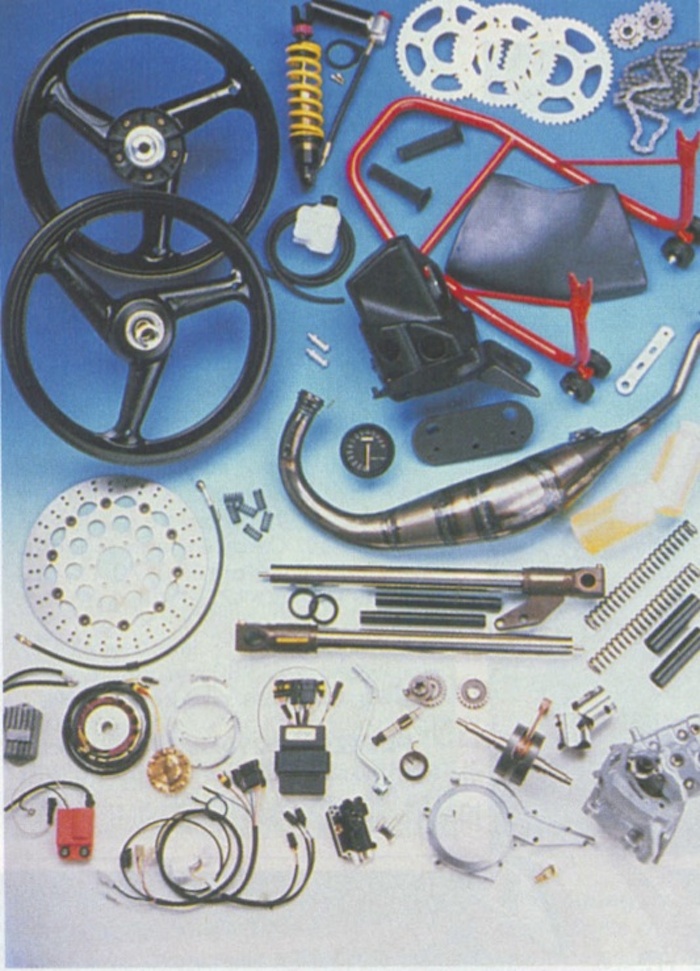
Il titolo di Campione Italiano 125 Sport Production Under 1994 viene assegnato alla Cagiva Mito EV 125 SP numero 26 di Valentino Rossi; il tricolore torna dopo un anno in quel di Varese e l’impatto mediatico è tale da incrementare notevolmente le vendite della Cagiva Mito EV 125; al debutto assoluto la nuova ottavo di litro Varesina ottiene il successo nella competizione più importante dedicata alle 125 SP.
Naturalmente, durante il salone di Milano del 1994, proprio per festeggiare il titolo ottenuto, viene presentata la Mito EV in livrea Lucky Explorer, avente i medesimi colori e grafiche della controparte racing e che per la prima volta adotta di serie (solo per la versione stradale) un carburatore Mikuni TMX 35 in luogo del conosciuto Dell’Orto PHBH 28.
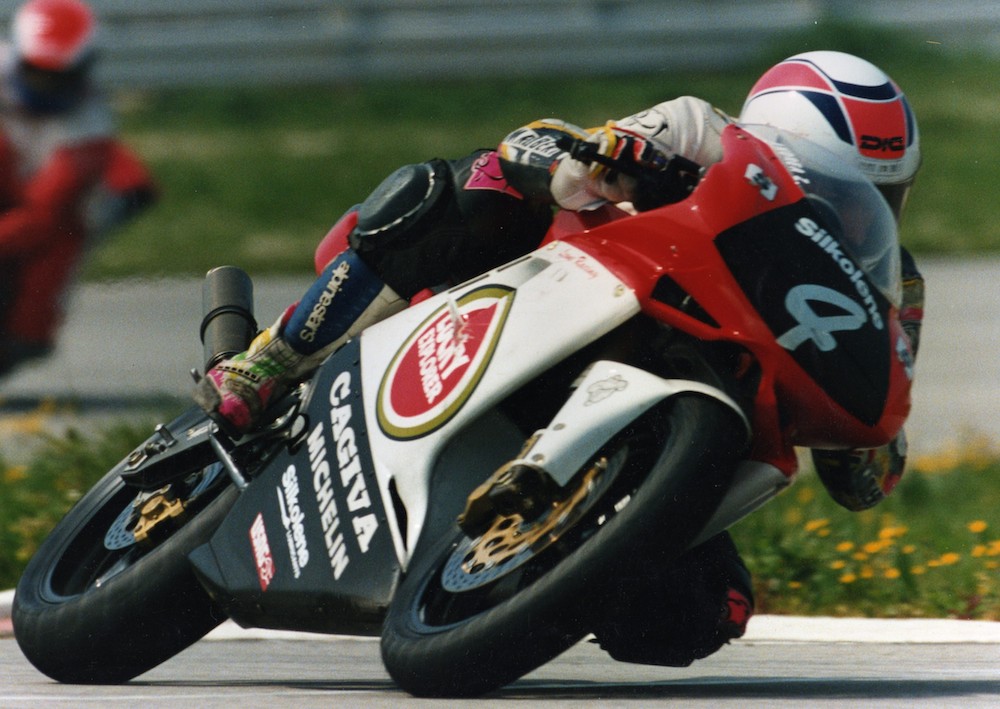
– Cagiva Mito EV Sport Production 1995 – 1996
La Cagiva Mito EV Sport Production in versione 1995 e 1996 continua ad evolvere quello che era stato sviluppato fino ad ora dal Reparto Corse. L’azienda Varesina si è ritirata da poco dal motomondiale 500 GP e tutte le risorse sono ora indirizzate allo sviluppo della nuova 4 tempi 750 SBK, l’attenzione verso la 125 SP e’ leggermente diminuita. Le differenze sostanziali rispetto alla versione precedente risiedono nell’adoziono del cilindro codice 81782, sviluppato durante la stagione 1994 e relativo kit, una una nuova testa 200M con squish arrotondato per pistoni Mahle (i medesimi della C594 da GP) ed un nuovo impianto di espansione. Su questa moto il kit di avviamento a kick starter è disponibile fin da subito, con la carenatura forata proprio all’attacco del millerighe della leva, la quale è asportabile (si avvia la moto in griglia di partenza e si estrae la la leva).
La livrea della moto, così come gli sponsor tecnici restano i medesimi delle stagioni predenti; le moto vengono affidate a vari team, ma escluso qualche exploit di Sanna (al debutto), Zappa, Massimi, Giordano e Massimiliano Blaso, queste stagioni sono avare di titoli per il team Cagiva Lucky Explorer.
– Cagiva Mito EV Sport Production 1997 – 1999
La massima evoluzione del kit Sport Production Cagiva si ottiene in questi ultimi anni grazie all’introduzione di un nuovo gruppo termico (90087) il quale adotta una nuova valvola di scarico e dei nuovi collettori di scarico e ad una nuova accensione realizzata da Kokusan a rotore esterno di minor peso rispetto a quella di serie. I cerchi Marchesini vengono sostituiti da quelli originali a “sei razze”; mentre quanto sviluppato fino ad ora è regolarmente acquistabile presso i concessionari autorizzati.
Arrivano le limitazioni a 11kw per le ottavo di litro e così crolla il mercato interno così come l’interesse per i sedicenni e dei media verso la Sport Production e di conseguenza anche l’impegno di Cagiva in forma ufficiale viene meno e lo sviluppo viene lasciato a team esterni o preparatori, fermo restando la possibilità di acquistare parti del kit fino al 2001.
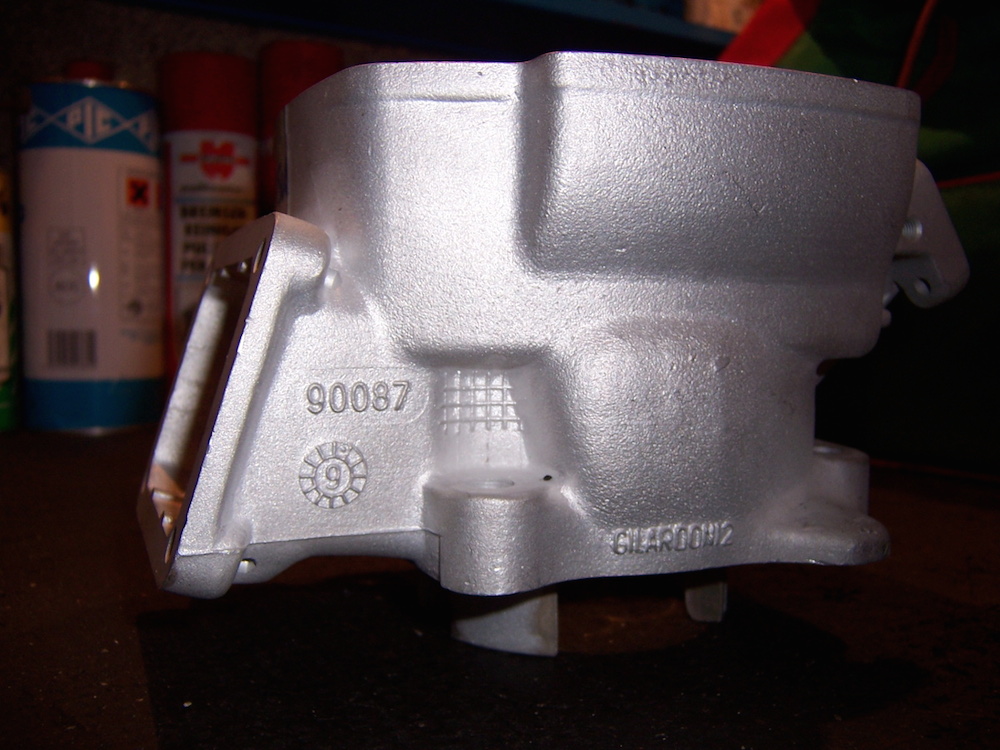
– Cagiva Mito SP 525 2006
Per la stagione 2006 Cagiva/MV Agusta decide, con la collaborazione e la struttura di Capirossi Safety School di organizzare un trofeo Mito SP, allestendo le Cagiva Mito EV in configurazione SP525, modello che poi, dal 2008 sarà regolarmente in vendita presso i concessionari.
Vengono modificati i telaietti anteriori e posteriori, così come le carenature complete, ora di ispirazione Cagiva GP 594; il mono ammortizzatore posteriore è regolabile con serbatoio esterno realizzato da FG Special Parts e Mupo, le pedane arretrate e o tamponi laterali sono realizzati dalla Valter Moto mentre l’accensione è Ducati Energia con apposita CDI; viceversa i cilindri sono serie 90087 con relativo Kit.
I tecnici Cagiva hanno ulteriormente sviluppato questa termica, fornendo le moto di apposite espansioni realizzate proprio per l’occasione. Il disco anteriore è realizzato dalla Braking e le forcelle anteriori vengono allestite in configurazione SP “doppia molla” con l’apposito KIT. La moto è acquistabile regolarmente e da piloti e team privati che vogliono misurarsi in questo splendido trofeo.
Così termina la storia ufficiale della Cagiva Mito Sport Production, nelle sue forme e nei suoi sviluppi. Come si può evidenziare, quanto realizzato è sempre stato finalizzato alla vendita del prodotto finale dalla prima all’ultima versione realizzata. Il marchio Cagiva è sempre stato legato alle competizioni, così come il nome Mito capace di dominare la scena delle 125 a 2 tempi per anni e anni; mai nome fu più azzeccato.
Michele Prontelli “Ceppa”
